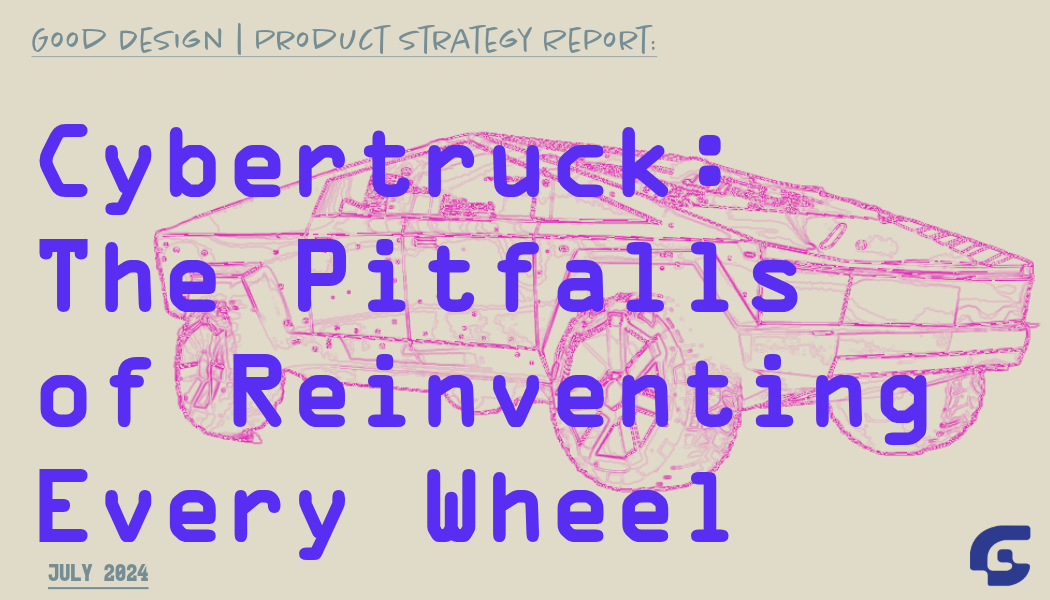Reimagining Product Strategy with the DVFU Framework
Good Ideas Only • 2024-02-22
The DVFU framework is a holistic approach to product strategy, integrating desirability, viability, feasibility, and usability to optimize decision-making and achieve product-market fit. By considering user needs, business potential, technical capacity, and adoption factors, organizations can mitigate risks and create winning products that resonate with consumers in today's dynamic technology landscape.
Successful product development is increasingly complex, with 85% of new offerings failing to achieve product-market fit. While design thinking, Jobs-to-be-Done (JTBD), and Lean Startup can help, but each has limitations. Design thinking needs more rigorous validation. JTBD overlooks emotional and social factors influencing adoption. Lean Startup principles manifest differently across industries. What technology firms need is an integrated approach tailored to their unique challenges. The DVFU framework delivers this solution.
DVFU Advances Strategy with Game Theory
DVFU stands for Desirability, Viability, Feasibility, and Usability - the core interdependent drivers of product success. By interweaving these elements, DVFU applies game theory to model uncertainty, analyze tradeoffs, and optimize complex decisions essential to modern product strategy.
Like expert chess players, product leaders can leverage DVFU to assess alternatives and predict competitive dynamics systematically. But as opposed to chess with perfect information, DVFU operates in fog-of-war conditions akin to poker, where information is incomplete, and opponents conceal their hands. By embracing experimentation and feedback loops, DVFU allows adaptation as new information emerges.
Applying DVFU to Transform Strategy & Execution
The DVFU framework guides product leaders through aligning vision and capabilities to customer needs:
Desirability Captures User Needs
Desirability focuses on ethnographic research, personas, and journey mapping to uncover user pain points. Continuous feedback refines concepts to resonate emotionally and functionally. For Airbnb, desirability meant recognizing the appetite for authentic travel experiences and affordable stays in residential locales rather than traditional hotels.
Viability Assesses Business Potential
Viability evaluates the business model's sustainability, TAM, competitive forces, and willingness to pay. Pricing strategy and revenue models are explored. Airbnb’s commission-based model provided the core viability the existing housing supply enabled.
Feasibility Covers Technical Capacity
Feasibility analyzes if current technical capabilities can deliver the product experience and identify R&D needs. Broad internet access and digital payment platforms were the primary technical enablers for Airbnb.
Usability Drives Adoption and Retention
Usability testing refines the UI/UX for seamless, intuitive experiences catering to diverse users. Like reviews and host profiles, website usability was essential for Airbnb to build user trust and safety.
Rapid Iteration & Validation
Cross-functional teams quickly prototype and test DVFU alignment. Agile processes enable customer-obsessed cultures and innovation.
DVFU In Action: IPod Case Study
Apple’s 2001 iPod launch demonstrates DVFU’s advantage. While portable MP3 players existed, Apple aimed to understand what users truly wanted. Ethnographic studies revealed people sought access to all of their music. This inspired the tagline - “1,000 songs in your pocket” - resonating powerfully with the target demographic.
The original 5GB iPod prototype only worked with Macs, limiting viability. Rapid iteration using DVFU factors led Apple to add Windows support in 2002, expanding its TAM quickly. With the hardware feasibility thanks to miniaturized hard drives and clean UI/UX nailing usability, the iPod achieved meteoric growth as competitors anchored to their initial designs fell behind.
The Perils of Overlooking DVFU
While DVFU offers a clear path to product-market fit, many must address its core elements adequately. Here are some cautionary tales of product failures that DVFU could have predicted and prevented.
Juicero’s Expensive Squeeze
Juicero’s $699 WiFi-connected juicer for exclusive pre-packaged juice packets was a notorious disaster. Despite $120 million in funding, the company collapsed 16 months after launching. Juicero overlooked several DVFU factors:
Desirability: The product needed a clear benefit/value over simply squeezing packets by hand for juice.
Viability: The high price limited adoption and Juicero lost money on device and packet sales.
Feasibility: Over-engineered custom juicing adds costs without an upside in usability.
Usability: Connectivity innovations felt superfluous to the core juicing function.
By overlooking DVFU, Juicero engineered an overpriced luxury product lacking a viable market.
Zillow’s Home Buying Blindspot
With “Zillow Offers,” Zillow failed to anticipate stakeholder responses fully:
- Sellers were now incentivized to solicit higher bids from traditional buyers over Zillow.
- Real estate agents stood to lose commissions, giving them a reason to stop promoting Zillow.
- Applying DVFU’s game theory lens could have allowed Zillow to innovate while aligning incentives:
Desirability: Lure sellers with home price guidance and fast sale guarantees
Viability: Provide “Zillow Backup Offer” to beat top bid to a set price
Feasibility: Leverage Zillow’s data/algorithms to accurately price homes
Usability: Simplify agent-assisted backup offer process for consumers
This approach would have increased seller desirability and preserved agent partnerships while capitalizing on Zillow’s core data assets and capabilities.
Think in DVFU
As these examples demonstrate, overlooking any component of the DVFU framework can derail product success. Leaders can mitigate risk by integrating desirability, viability, feasibility, and usability into strategic decision-making and unlock winning products attuned to evolving consumer needs.
Path Forward
In today’s dynamic technology landscape, DVFU provides a structured approach that integrates proven frameworks to deliver products that match evolving consumer needs. Just as expert poker players leverage game theory, tech leaders can apply DVFU to gain a strategic advantage in the high-stakes competition for product-market fit. The question you must ask is - can you afford not to?
The GIO Team
About The Good Design | Center of Excellence Newsletter
For digital leaders aiming to drive growth through human-centric innovation, the Good Design Center of Excellence newsletter offers an inside look at GIO's approach. You'll gain strategic insights through digestible videos and articles to bridge the gap between vision and execution.





